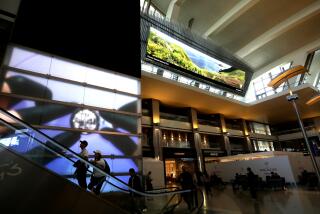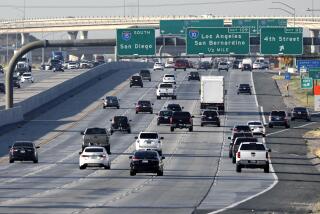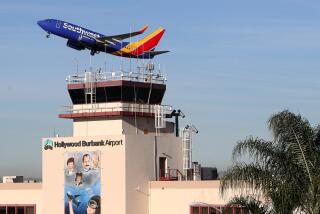El Toro Plan Defies Trend in Runway Spacing
- Share via
Plans for an airport at the El Toro Marine Corps Air Station call for runways that are much closer together than those being built or proposed at other U.S. airports, raising concerns by some about safety and efficiency.
Under the proposal, 800 feet would separate two north-south runways, and 700 feet would separate two east-west runways. Around the country, cities are building or contemplating new runways with double or triple that spacing.
The wider distance allows airports to handle more flights, including simultaneous departures and arrivals during any weather conditions. It also reduces the chances that wake turbulence from a bigger jet could affect a smaller one.
County officials say wider runway spacing at El Toro would increase the cost and extend jet noise farther into the community. The current plan, they say, allows for a safe and efficient airport. Still, they are continuing to study the concept of wider distances between runways, which is becoming the standard.
Denver’s new airport, for example, has a 5,280-foot separation between runways. New runways under construction or planned in Dallas, San Francisco, Seattle and Louisville, Ky., call for separations from 1,800 to 5,300 feet.
“Definitely, the movement is toward greater widths between runways,” said Larry Bauman, senior airport planner at Dallas-Ft. Worth International Airport. “We have some runways built in the 1960s that have 800-foot separations. But we weren’t getting the best bang for the buck. We consider the wider separations to be more up to date.”
The county acknowledges that the proposed El Toro design would place some limits on operations. Jets, for example, could not land simultaneously unless they were the same model, a rule intended to prevent problems from wake turbulence (wind from a larger plane that can cause a smaller plane to lose control).
Even with these limitations, the county estimates that the airport could handle at least 25 million passengers and 500 daily flights a year by 2020.
Wider runway spacing at El Toro presents several problems. For one, it would swell the cost of the airport, now estimated at $1.4 billion, because the existing military runways would have to be removed and new ones built. No one is sure yet how much that would cost.
The redesign also would change the flight paths for arrivals and departures, sending jets over communities next to the airport that are now spared heavy jet noise. The current plan calls for commercial jets to use the same flight path military jets have used.
Two pilots unions and opponents of the entire airport proposal say the runway separations are a key concern. County planners, knowing the issue will reemerge when the Board of Supervisors takes a final vote on the airport plan next year, have decided to prepare a detailed study of wider separations.
“We want to explore all options out there,” said Courtney Wiercioch, the county’s El Toro program manager. “We don’t want people to say [next year] that we didn’t look into it.”
The issue also has been raised at other airports. Earlier this month, a report by the International Air Line Pilots Assn. raised concerns about the 750-foot runway separations at San Francisco International Airport.
Officials for the association, the largest pilots’ union in the country, said the airport is safe, but urged pilots to use extra caution, they said, because the runways are so close together that they could be confused in poor visibility. Mitch Barker, a spokesman for the Federal Aviation Administration, said that the runway spacing both at San Francisco and the proposed El Toro airport meet the agency’s minimum recommendations. Under FAA standards, airports with narrower separations should handle less air traffic at any given time than those with wider spacing.
Constructing parallel runways 700 to 900 feet apart was a common practice during the airport building boom of the 1960s, and most of those runways continue to be used today.
But airport directors and aviation experts saw the limitations of the design and began moving toward much larger separations in the 1980s.
In addition to San Francisco, Dallas-Ft. Worth and Seattle-Tacoma have parallel runways 700 to 900 feet apart. But each airport now is either proposing or building additional runways with much wider separations. San Francisco’s proposed parallel runways would be 4,300 feet apart.
Louisville International Airport recently reconfigured its tarmac, constructing parallel runways 4,800 feet apart. Doug Stern, a spokesman for that airport, said they allow Louisville to handle more flights during peak hours. They also allow for simultaneous arrivals and simultaneous departures even during low-visibility weather, a large advantage for cargo carriers who run on tight schedules.
“We discovered that when your runway is closer together, you sacrifice capacity,” he said.
El Toro, even with narrower spacing, could have some simultaneous landings and departures during clear weather. Two 747s, for example, could land together, but a 747 and a 727 would have to land at staggered times to avoid any risk from wake turbulence, said Ron Ahlfedt, the county’s chief airport consultant.
Barry Dempsey, a civil engineering professor at the University of Illinois and an expert on runway design, said the trend toward wider spacing comes in response to the rapid growth in air service.
“Airline [ticket] sales are phenomenal, and you are talking about a 3% to 5% increase in [passenger demand] each year,” he said. “Airports are struggling to keep up. Wider separations help improve capacity as well as safety.”
They also make sense, experts say, given the possibility that airports eventually might have to handle so-called “super jumbo” jets, massive aircraft that can seat 500 to 650 passengers and have wingspans significantly longer than existing jets.
Dempsey agreed, however, that the key downside to the trend are the extended flight paths and, therefore, noise. This is a key concern of Orange County officials, because noise is the biggest issue raised by South County residents who oppose the El Toro plan.
Officials will prepare an environmental impact report on the entire airport plan over the next year before the board takes a final vote.
Under the plan endorsed earlier this year by the board, the base’s two existing sets of parallel runways, two east-west and two north-south and each set about 500 feet apart, would be widened by 200 to 300 feet.
Under another option also being studied, but not recommended by staff, the airport would have two runways rather than four. They would run north-south, separated by 3,000 feet. A passenger terminal would be built between them in a design similar to Denver’s airport. The study of wider runway spacing will examine how that would change El Toro’s capacity and noise conditions for nearby residents. Ahlfedt said the scenario probably would extend the current arrival pattern through Laguna Niguel, Laguna Hills and Leisure World.
The county hasn’t considered the idea of four wider-spaced runways, which officials said would leave less room on the 4,700-acre base for other proposed projects such as hotels and office towers.
“The more runways you put on the site, the less room you have for development,” Ahlfedt said.
(BEGIN TEXT OF INFOBOX / INFOGRAPHIC)
Too Close for Comfort?
The county’s El Toro airport plans call for two sets of parallel runways separated by 700 to 800 feet, even though many airports around the country are building runways with separations double or triple that width. Greater separations improve capacity and safety.
1) The airport plan endorsed by the Board of Supervisors earlier this year.
2) Concept for an El Toro airport with two runways separated by 3,000 feet with a passenger terminal in the middle.
Source: County of Orange
More to Read
Sign up for Essential California
The most important California stories and recommendations in your inbox every morning.
You may occasionally receive promotional content from the Los Angeles Times.











